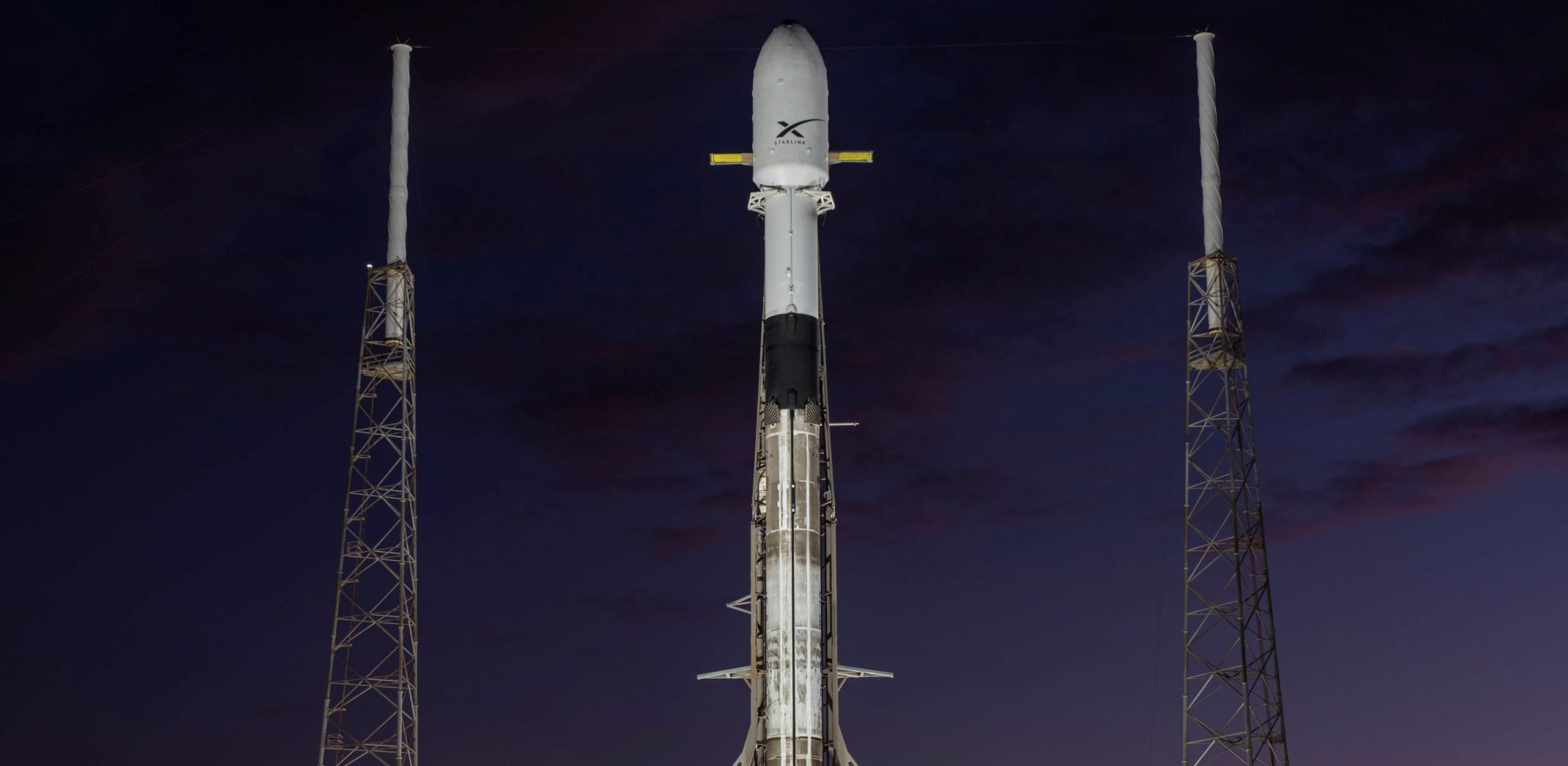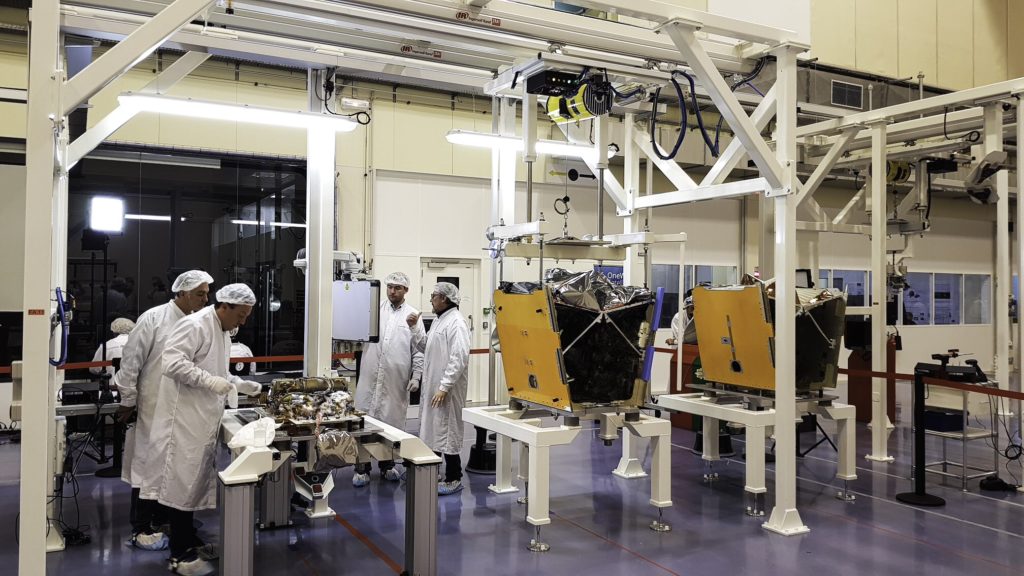

News
SpaceX announces second Starlink satellite launch in two weeks
SpaceX has announced its second planned Starlink satellite in two weeks, sticking to a trend that could see the company launch more than a thousand communications satellites over the next 12 months.
Barely two weeks after SpaceX opened media accreditation for Starlink-2, the second launch of finalized ‘v1.0’ satellites and third dedicated launch overall, the company has announced that that late-December mission will be followed by another Starlink launch in January 2020. This tracks almost exactly with SpaceX’s reported plans for as many as 24 dedicated Starlink launches in 2020, a feat that would singlehandedly break SpaceX’s current record of 21 launches performed in a single year.
As previously discussed on Teslarati, SpaceX opened media accreditation for Starlink-2 on November 24th, confirming that the company hopes to complete one more 60-satellite Starlink launch before the end of 2019. That mission is currently targeted no earlier than (NET) late-December and would be SpaceX’s last launch of 2019 if current schedules hold.
Regardless of when it happens, there’s a strong chance that the 60 Starlink-2 satellites will make SpaceX the world’s largest individual satellite operator, potentially raising the number of satellites under the company’s command to ~170. According to SpaceX’s announcement, Starlink-3 – another 60-satellite mission – is now scheduled to launch no earlier than January 2020. If Starlink-2 is successful and no more v0.9 spacecraft drop out of the operational constellation, it can be said with certainty that Starlink-3 will unequivocally make SpaceX the world’s largest satellite operator.
Incredibly, if those schedules hold, SpaceX will have gone from two satellites in orbit to the world’s largest satellite constellation operator – by a large margin – in as few as nine months. In fact, after cresting that peak, it will take nothing short of a miracle for SpaceX to be usurped. The company hopes to launch as many as 24 Starlink missions in 2020 and is simply miles ahead of its competitors in its efforts to make high-performance orbital launches as efficient and affordable as possible.
If SpaceX and its executives are to be believed, as early as the very first dedicated Starlink launch (May 2019), the cost of launching Falcon 9 was already significantly less than the cost of its payload of 60 Starlink v0.9 satellite prototypes. CEO Elon Musk and COO Gwynne Shotwell have strongly implied that the per-satellite cost is already well below $500,000, meaning that the absolute worst-case internal cost of a Falcon 9 launch is less than $30M.
If, for example, each Starlink satellite already costs as little as $250,000 to build, it’s possible that SpaceX can already launch a dedicated 60-satellite mission (including launch costs) at an internal cost of less than $30M ($15M for launch, $15M for 60 satellites). Even in the former scenario, a single Starlink launch might cost SpaceX has little as $60M in total.
In a best-case scenario for megaconstellation competitor OneWeb, the company purchased up to 21 Soyuz launches from Roscosmos for “more than $1 billion”, translating to roughly $50 million per launch (rocket costs only). Meanwhile, OneWeb’s satellite design is far more traditional and Soyuz offers significantly less performance than Falcon 9, resulting in a cap of 34 ~150 kg (330 lb) per launch. Finally, OneWeb hopes to build each satellite for about $1M, translating to a best-case per-launch cost of ~$85 million. OneWeb aims to launch once per month after its first 34-satellite mission, currently NET January 30th, 2020.

This is all a very roundabout way of illustrating the fact that once SpaceX becomes the world’s largest satellite operator, nothing short of repeated launch failures or the company’s outright collapse will prevent it from retaining that crown for the indefinite future. Once OneWeb has completed all 21 of its planned Soyuz launches, a milestone unlikely to come before mid-2021, it will have a constellation of ~700 satellites.
Even if SpaceX falters and manages a monthly Starlink launch cadence over the next 13 months, the constellation could surpass OneWeb’s Phase 1 plans as early as Q3 2020 – up to as early as June 2020 if SpaceX manages a biweekly cadence. By the time OneWeb’s constellation is complete, SpaceX could potentially have more than 2000 operational satellites in orbit – perhaps ~600 metric tons of spacecraft compared to OneWeb’s ~100 metric tons.
Check out Teslarati’s Marketplace! We offer Tesla accessories, including for the Tesla Cybertruck and Tesla Model 3.

News
Tesla (TSLA) receives “Buy” rating and $551 PT from Canaccord Genuity
He also maintained a “Buy” rating for TSLA stock over the company’s improving long-term outlook, which is driven by autonomy and robotics.

Canaccord Genuity analyst George Gianarikas raised his Tesla (NASDAQ:TSLA) price target from $482 to $551. He also maintained a “Buy” rating for TSLA stock over the company’s improving long-term outlook, which is driven by autonomy and robotics.
The analyst’s updated note
Gianarikas lowered his 4Q25 delivery estimates but pointed to several positive factors in the Tesla story. He noted that EV adoption in emerging markets is gaining pace, and progress in FSD and the Robotaxi rollout in 2026 represent major upside drivers. Further progress in the Optimus program next year could also add more momentum for the electric vehicle maker.
“Overall, yes, 4Q25 delivery expectations are being revised lower. However, the reset in the US EV market is laying the groundwork for a more durable and attractive long-term demand environment.
“At the same time, EV penetration in emerging markets is accelerating, reinforcing Tesla’s potential multi‑year growth runway beyond the US. Global progress in FSD and the anticipated rollout of a larger robotaxi fleet in 2026 are increasingly important components of the Tesla equity story and could provide sentiment tailwinds,” the analyst wrote.
Tesla’s busy 2026
The upcoming year would be a busy one for Tesla, considering the company’s plans and targets. The autonomous two-seat Cybercab has been confirmed to start production sometime in Q2 2026, as per Elon Musk during the 2025 Annual Shareholder Meeting.
Apart from this, Tesla is also expected to unveil the next-generation Roadster on April 1, 2026. Tesla is also expected to start high-volume production of the Tesla Semi in Nevada next year.
Apart from vehicle launches, Tesla has expressed its intentions to significantly ramp the rollout of FSD to several regions worldwide, such as Europe. Plans are also underway to launch more Robotaxi networks in several more key areas across the United States.
News
Waymo sues Santa Monica over order to halt overnight charging sessions
In its complaint, Waymo argued that its self-driving cars’ operations do not constitute a public nuisance, and compliance with the city’s order would cause the company irreparable harm.

Waymo has filed a lawsuit against the City of Santa Monica in Los Angeles County Superior Court, seeking to block an order that requires the company to cease overnight charging at two facilities.
In its complaint, Waymo argued that its self-driving cars’ operations do not constitute a public nuisance, and compliance with the city’s order would cause the company irreparable harm.
Nuisance claims
As noted in a report from the Los Angeles Times, Waymo’s two charging sites at Euclid Street and Broadway have operated for about a year, supporting the company’s growing fleet with round-the-clock activity. Unfortunately, this has also resulted in residents in the area reportedly being unable to sleep due to incessant beeping from self-driving taxis that are moving in and out of the charging stations around the clock.
Frustrated residents have protested against the Waymos by blocking the vehicles’ paths, placing cones, and “stacking” cars to create backups. This has also resulted in multiple calls to the police.
Last month, the city issued an order to Waymo and its charging partner, Voltera, to cease overnight operations at the charging locations, stating that the self-driving vehicles’ activities at night were a public nuisance. A December 15 meeting yielded no agreement on mitigations like software rerouting. Waymo proposed changes, but the city reportedly insisted that nothing would satisfy the irate residents.
“We are disappointed that the City has chosen an adversarial path over a collaborative one. The City’s position has been to insist that no actions taken or proposed by Waymo would satisfy the complaining neighbors and therefore must be deemed insufficient,” a Waymo spokesperson stated.
Waymo pushes back
In its legal complaint, Waymo stated that its “activities at the Broadway Facilities do not constitute a public nuisance.” The company also noted that it “faces imminent and irreparable harm to its operations, employees, and customers” from the city’s order. The suit also stated that the city was fully aware that the Voltera charging sites would be operating around the clock to support Waymo’s self-driving taxis.
The company highlighted over one million trips in Santa Monica since launch, with more than 50,000 rides starting or ending there in November alone. Waymo also criticized the city for adopting a contentious strategy against businesses.
“The City of Santa Monica’s recent actions are inconsistent with its stated goal of attracting investment. At a time when the City faces a serious fiscal crisis, officials are choosing to obstruct properly permitted investment rather than fostering a ‘ready for business’ environment,” Waymo stated.
News
Tesla FSD v14.2.2 is getting rave reviews from drivers
So far, early testers have reported buttery-smooth drives with confident performance, even at night or on twisty roads.

Tesla Full Self-Driving (Supervised) v14.2.2 is receiving positive reviews from owners, with several drivers praising the build’s lack of hesitation during lane changes and its smoother decision-making, among others.
The update, which started rolling out on Monday, also adds features like dynamic arrival pin adjustment. So far, early testers have reported buttery-smooth drives with confident performance, even at night or on twisty roads.
Owners highlight major improvements
Longtime Tesla owner and FSD user @BLKMDL3 shared a detailed 10-hour impression of FSD v14.2.2, noting that the system exhibited “zero lane change hesitation” and “extremely refined” lane choices. He praised Mad Max mode’s performance, stellar parking in locations including ticket dispensers, and impressive canyon runs even in dark conditions.
Fellow FSD user Dan Burkland reported an hour of FSD v14.2.2’s nighttime driving with “zero hesitations” and “buttery smooth” confidence reminiscent of Robotaxi rides in areas such as Austin, Texas. Veteran FSD user Whole Mars Catalog also demonstrated voice navigation via Grok, while Tesla owner Devin Olsen completed a nearly two-hour drive with FSD v14.2.2 in heavy traffic and rain with strong performance.
Closer to unsupervised
FSD has been receiving rave reviews, even from Tesla’s competitors. Xpeng CEO He Xiaopeng, for one, offered fresh praise for FSD v14.2 after visiting Silicon Valley. Following extended test drives of Tesla vehicles running the latest FSD software, He stated that the system has made major strides, reinforcing his view that Tesla’s approach to autonomy is indeed the proper path towards autonomy.
According to He, Tesla’s FSD has evolved from a smooth Level 2 advanced driver assistance system into what he described as a “near-Level 4” experience in terms of capabilities. While acknowledging that areas of improvement are still present, the Xpeng CEO stated that FSD’s current iteration significantly surpasses last year’s capabilities. He also reiterated his belief that Tesla’s strategy of using the same autonomous software and hardware architecture across private vehicles and robotaxis is the right long-term approach, as it would allow users to bypass intermediate autonomy stages and move closer to Level 4 functionality.








